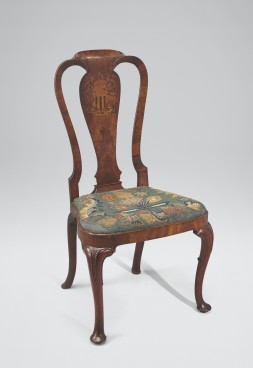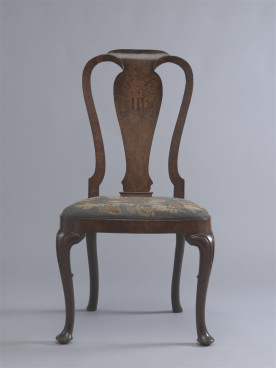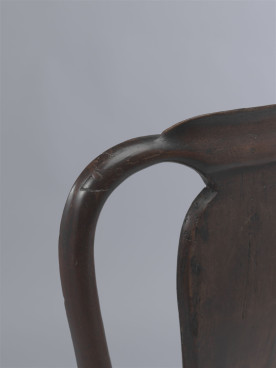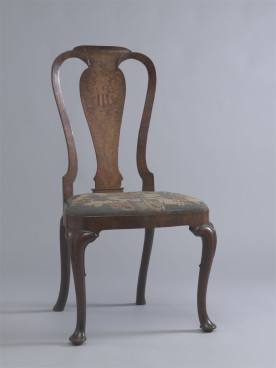Chair, c.1725–40
Walnut with possibly original needlework
The back splat is inlaid with the arms of Martin of Wivenhoe, Essex, granted to Captain Matthew Martin (1676–1749) in 1722. This chair is one of a pair from a larger set.
Adam Bowett Catalogue (19/08/2012)
Description
A pair of walnut chairs, c.1730. The waisted and scrolled back has a baluster splat inlaid with the arms of Martin, over a needlework slip seat on compass rails and slender cabriole legs with pad feet and slightly curved ogee back feet.
Dimensions
H: 40 ½” (103cm) Seat height: 17 ¼ ” (44cm) W: 22 ” (56cm) D: 20 ½ “ (52cm)
Materials
Walnut, beech
Dating criteria
Apart from the chairs’ stylistic attributes, the inlaid crest on the backs was granted in 1722, which gives a firm terminus post quem for the chairs.
Construction
The back posts are solid walnut and veneered on their forward faces above the seat and pieced out in the usual manner to exaggerate the curvature; they are half-lapped to the top rail. The splat is beech, tenoned into the top rail and into the shoe, veneered on its forward face and inlaid with the arms of Martin. The seat rail is beech, tenoned into the back posts, and secured with double pegs. It appears that the mortises were cut slightly too deep as slim wedges have been inserted in both. The seat rails are beech, veneered with walnut and with an applied raised edge to create a rebate for the slip seat. The side rails are tenoned into the rear posts and the front legs are mortised into the side and front rails. The seat is braced across all four corner with nailed beech braces. The fore legs are solid and supported by shaped brackets with crudely shaped blocks behind.
Marks or stamps
25.1 – The inside of the back seat rail is marked III.
25.2 – The inside of the back seat rail is marked V.
Condition
25.1 – The back of the splat and the back seat rail are varnished to resemble walnut. There are repaired breaks on both sides of the joint between crest rail and rear posts. Pegs to both joints at seat rail to back post appear original. There are cracks and some losses to the veneers on the seat rails. The nailed corner blocks are old but possibly not original. The brackets and corresponding blocks appear to be original. Both front feet have circular walnut pads nailed to them to raise them in height.
25.2 – Principally sound, some losses and cracking to the veneers on the seat rail, some movement particularly right front leg joint. Triangular corner braces old but probably not original. Front leg brackets and support blocks apparently original, ditto to the rear.
Additional remarks
The crest on these chairs is that of Captain Matthew Martin of Wivenhoe, Essex.
Martin was born in Wivenhoe in 1676, the son of a former mariner, Samuel Martin, who died in 1694. About 1702 he married Sarah Jones, the daughter of an East India captain living in Stepney, Middlesex, and by 1710 Martin was himself a captain in the service of the East India Company. He achieved enduring fame and substantial wealth while in command of the Marlborough (480 tons and 32 guns). In October or November 1712 the Marlborough was en route from China to the East India Company station at Fort St George (near Madras) with a cargo valued at £200,000 when it was attacked by three French ships. His successful defence gained him a reward of £1,000 and a large diamond-studded medal; the latter is visible in a portrait painted shortly after the action.
Martin sat as a Whig MP between 1722 and 1727, and became Mayor of Colchester in 1726. He was a governor of St Thomas’s Hospital, London 1732-44, and died in 1746. The arms shown on the back of the chair were granted in 1722; what appears to be an alteration in the top left-hand corner of the shield is in fact a faithful representation of the arms as granted. Hence the chairs date from after 1722 and before Martin’s death in 1746. On stylistic grounds the chairs probably date from 1725-1735.
References
Morant, The History and Antiquities of the County of Essex, Vol. II, 1768, London, Reprinted by E.P. Publishing, Wakefield, 1978, 188-9.
Pat Marsden, ‘Wivenhoe House: A Tale of Two Lost 18th Century Mansions and the Sea-Captains who Built Them’, The Essex Society for Archaeology and History, Transactions, Vol. 1, 4th Series, 2010, pp.284-302.
Also at www.wivenhoe.gov.uk
Provenance
Purchased Alastair Sampson October 1986
Chairman Young Collection


















